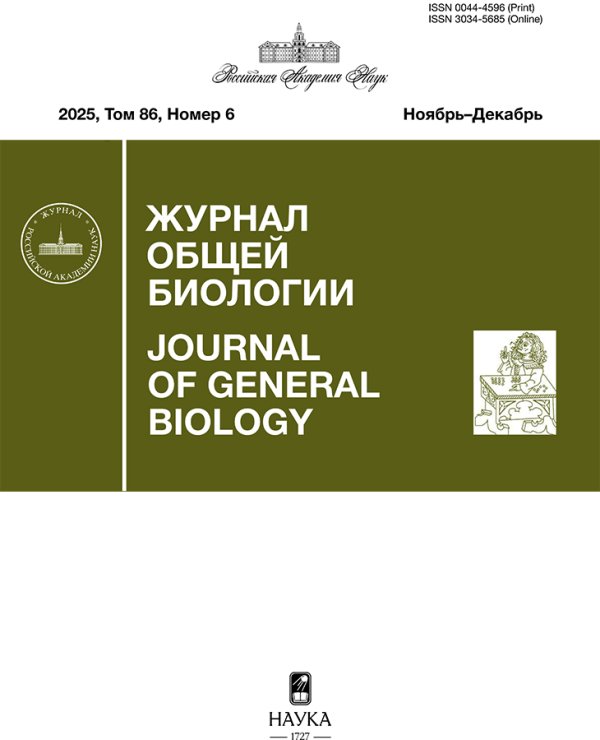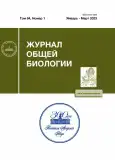Intraspecific typing and phylogeny of the causative agent of the plague – the microbe Yersinia pestis: Problems and perspectives
- Authors: Suntsov V.V.1
-
Affiliations:
- Severtsov Institute of Ecology and Evolution, RAS
- Issue: Vol 84, No 1 (2023)
- Pages: 67-80
- Section: Articles
- URL: https://journals.rcsi.science/0044-4596/article/view/136442
- DOI: https://doi.org/10.31857/S0044459623010086
- EDN: https://elibrary.ru/ANSOBQ
- ID: 136442
Cite item
Full Text
Abstract
Two approaches to typing (analysis of intraspecific diversity) and reconstruction of the phylogeny (evolutionary history) of the causative agent of the plague – the microbe Yersinia pestis – molecular genetic (MG) and ecological (adaptationist, on the basis of host adaptation) are considered. It is shown that each of the approaches has its advantages and disadvantages. MG-typing of pathogen strains in the studied foci of the world made it possible to characterize up to 30 subspecies/genovariants of the plague microbe, but the phylogeny of the microbe built on the basis of this diversity contradicts some obvious environmental facts. The ecological scenario of the origin and evolution of the causative agent of the plague has no obvious contradictions and, as an evolutionarily based hypothesis, it should be taken into account in MG reconstructions of the phylogeny of the plague microbe. The prospect of research in this direction is seen in integrating molecular-genetic (statistical) and ecological (adaptationist) approaches.
About the authors
V. V. Suntsov
Severtsov Institute of Ecology and Evolution, RAS
Author for correspondence.
Email: vvsuntsov@rambler.ru
Russia, 119071, Moscow, Leninsky Pr., 33
References
- Абрамсон Н.И., 2007. Филогеография: итоги, проблемы, перспективы // Вестн. ВОГиС. Т. 11. № 2. С. 307–331.
- Абрамсон Н.И., 2013. Молекулярная и традиционная филогенетика. На пути к взаимопониманию // Тр. Зоол. ин-та РАН. Приложение 2. С. 219–229.
- Анисимов Н.В., Кисличкина А.А., Платонов М.Е., Евсеева В.В., Кадникова Л.А. и др., 2016. О происхождении гипервирулентности возбудителя чумы // Мед. паразитол. и паразит. болезни. № 1. С. 36–42.
- Вагайская А.С., Трунякова А.С., Дентовская С.В., 2019. Внутривидовая дифференциация Yersinia pestis: от фенотипа к полногеномному секвенированию // Бактериология. Т. 4. № 2. С. 42–54.
- Горшков О.В., Савостина Е.П., Попов Ю.А., Плотников О.П., Виноградова Н.А., Солодовников Н.С., 2000. Генотипирование штаммов Yersinia pestis из различных природных очагов // Мол. генетика, микробиол., вирусол. № 3. С. 12–17.
- Ерошенко Г.А., Краснов Я.М., Носов Н.Ю., Куклева Л.М., Никифоров К.А. и др., 2015. Совершенствование подвидовой классификации Yersinia pestis на основе данных полногеномного секвенирования штаммов из России и сопредельных государств // Пробл. особо опасн. инф. № 4. С. 58–64.
- Кисличкина А.А., Платонов М.Е., Вагайская А.С., Богун А.Г., Дентовская С.В., Анисимов А.П., 2019. Рациональная таксономия Yersinia pestis // Мол. генетика, микробиол., вирусол. Т. 37. № 2. С. 76–82.
- Носов Н.Ю., Оглодин Е.Г., Краснов Я.М., Куклева Л.М., Шавина Н.Ю. и др., 2016. Филогенетический анализ штаммов Yersinia pestis средневекового биовара из природных очагов чумы Российской Федерации и сопредельных стран // Пробл. особо опасн. инф. № 2. С. 75–78.
- Павлинов И.Я., 2005. Введение в современную филогенетику. М.: Т-во науч. изд. КМК. 391 с.
- Павлова А.И., Ерошенко Г.А., Одиноков Г.Н., Куклева Л.М., Шавина Н.Ю. и др., 2012. Анализ генетической изменчивости штаммов Yersinia pestis средневекового биовара из природных очагов чумы России и Монголии // Пробл. особо опасн. инф. № 114. С. 49–53.
- Платонов М.Е., Евсеева В.В., Дентовская С.В., Анисимов А.П., 2013. Молекулярное типирование Yersinia pestis // Мол. генетика, микробиол., вирусол. № 2. С. 3–13.
- Савостина Е.П., Попов Ю.А., Каштанова Т.Н., Виноградова Н.А., Плотников О.П., Балахонов С.В., 2009. Геномный полиморфизм штаммов основного подвида возбудителя чумы // Мол. генетика, микробиол., вирусол. № 4. С. 23–27.
- Сунцов В.В., 2018а. Генезис трансмиссивной передачи микроба чумы Yersina pestis: два подхода – молекулярно-генетический и экологический // Пробл. особо опасн. инф. № 2. С. 37–44.
- Сунцов В.В., 2018б. Исключительная роль специфической блохи сурков Oropsylla silantiewi (Ceratophillidae: Siphonaptera) в видообразовании возбудителя чумы – микроба Yersinia pestis // Паразитология. Т. 52. № 1. С. 3–18.
- Сунцов В.В., 2020а. Гостальный аспект территориальной экспансии микроба чумы Yersinia pestis из популяций монгольского сурка-тарбагана (Marmota sibirica) // Зоол. журн. Т. 99. № 11. С. 1307–1320.
- Сунцов В.В., 2020б. Перспективы синтеза молекулярно-генетического и экологического подходов к проблеме видообразования микроба чумы Yersinia pestis // Успехи соврем. биологии. Т. 140. № 1. С. 43–57.
- Сунцов В.В., 2021а. Политопное видообразование микроба чумы Yersinia pestis как причина филогенетической трихотомии в географических популяциях монгольского сурка-тарбагана (Marmota sibirica) // Журн. общ. биологии. Т. 82. № 6. С. 431–444.
- Сунцов В.В., 2021б. Геномогенез микроба чумы Yersinia pestis как процесс мозаичной эволюции // Генетика. Т. 57. № 2. С. 140–154.
- Сунцов В.В., 2022а. Изменения климата в Центральной Азии как предпосылки и триггер видообразования микроба чумы Yersinia pestis // Сиб. экол. журн. № 4. С. 451–463.
- Сунцов В.В., 2022б. Филогенез микроба чумы Yersinia pestis: уникальность эволюционной модели // Вестн. РАН. Т. 92. № 9. С. 36–44.
- Сунцов В.В., Сунцова Н.И., 2000. Экологические аспекты эволюции микроба чумы Yersinia pestis и генезис природных очагов // Изв. РАН. Сер. биол. № 6. С. 645–657.
- Сунцов В.В., Сунцова Н.И., 2006. Чума. Происхождение и эволюция эпизоотической системы (экологические, географические и социальные аспекты). М.: КМК. 247 с.
- Сунцов В.В., Сунцова Н.И., 2008. Макро- и микроэволюция в проблеме происхождения и мировой экспансии возбудителя чумы Yersinia pestis // Изв. РАН. Сер. биол. № 4. С. 389–395.
- Туманский В.М., 1957. О классификации разновидностей чумного микроба // Журн. микробиол., эпидемиол., иммунол. № 6. С. 3–7.
- Achtman M., 2008. Evolution, population structure and phylogeography of genetically monomorphic bacterial pathogens // Annu. Rev. Micribiol. V. 62. P. 53–70.
- Achtman M., 2012. Insights from genomic comparisons of genetically monomorphic bacterial pathogenes // Phil. Trans. R. Soc. B. V. 367. P. 860–867.
- Achtman M., Zurth K., Morelli G., Torrea G., Guiyoule A., et al., 1999. Yersinia pestis, the cause of plague, is a recently emerged clone of Yersinia pseudotuberculosis // PNAS. V. 96. № 24. P. 14043–14048.
- Achtman M., Morelli G., Zhu P., Wirth T., Diehl I., et al., 2004. Microevolution and history of the plague bacillus, Yersinia pestis // PNAS. V. 101. № 51. P. 17837–17842.
- Cui Y., Yu C., Yan Y., Li D., Li Y., et al., 2013. Historical variations in mutation rate in an epidemic pathogen, Yersinia pestis // PNAS. V. 110. № 2. P. 577–582.
- Demeure C.E., Dussurget O., Fiol G.M., Le Guern A.-S., Savin C., Pizarro-Cerda J., 2019. Yersinia pestis and plague: An updated view on evolution, virulence determinants, immune subversion, vaccination, and diagnostics // Genes Immun. V. 20. № 5. P. 357–370.
- Devignat R., 1951. Varietes de l’espece Pasteurella pestis. Nouvelle hypothese // Bull. WHO. V. 4. № 2. P. 242–263.
- Eppinger M., Rosovitz M.J., Fricke W.F., Rasko D.A., Kokorina G., et al., 2007. The complete genome sequence of Yersinia pseudotuberculosis IP31758, the causative agent of Far East scarlet-like fever // PLoS Genet. V. 3. № 8. P. 1508–1523.
- Hinnebusch B.J., Chouikha I., Sun Y.-C., 2016. Ecological opportunity, evolution, and the emergence of flea-borne plague // Infect. Immun. V. 84. № 7. P. 1932–1940.
- Hinnebusch B.J., Jarrett C.O., Bland D.M., 2017. “Fleaing” the plague: Adaptations of Yersinia pestis to its insect vector that lead to transmission // Annu. Rev. Microbiol. V. 71. P. 215–232.
- Kutyrev V.V., Eroshenko G.A., Motin V.L., Nosov N.Y., Krasnov J.M. et al., 2018. Phylogeny and classification of Yersinia pestis through the lens of strains from the plague foci of Commonwealth of Independent States // Front. Microbiol. V. 9. https://doi.org/10.3389/fmicb.2018.01106
- Lemon A., Cherzan N., Vadyvaloo V., 2020. Influence of temperature on development of Yersinia pestis foregut blockage in Xenopsylla cheopis (Siphonaptera: Pulicidae) and Oropsylla montana (Siphonaptera: Ceratophyllidae) // J. Med. Entomol. V. 57. № 6. P. 1997–2007.
- Li Y., Cui Y., Hauck Y., Platonov V.E., Dai E., Song Y., et al., 2009. Genotyping and phylogenetic analysis of Yersinia pestis by MLVA: Insights into the worldwide expansion of Central Asia plague foci // PLoS One. V. 4. № 6. https://doi.org/10.1371/journal.pone.0006000
- Morelli G., Song Y., Mazzoni C.J., Eppinger M., Roumagnac P. et al., 2010. Yersinia pestis genome sequencing identifies patterns of global phylogenetic diversity // Nat. Genet. V. 42. № 12. P. 1140–1143.
- Pisarenko S.V., Evchenko A.Yu., Kovalev D.A., Evchenko Y.M., Bobrysheva O.V. et al., 2021. Yersinia pestis strains isolated in natural plague foci of Caucasus and Transcaucasia in the context of the global evolution of species // Genomics. V. 113. № 4. P. 1952–1961.
- Rasmussen S., Allentoft M.E., Nielsen K., Orlando L., Sikora M., et al., 2015. Early divergent strains of Yersinia pestis in Eurasia 5,000 years ago // Cell. V. 163. P. 571–582.
- Riehm J.M., Vergnaud G., Kiefer D., Damdindorj T., Dashdavaa D., et al., 2012. Yersinia pestis lineages in Mongolia // PLoS One. V. 7. № 2. https://doi.org/10.1371/journal.pone.0030624
- Skurnik M., Peippo A., Ervela E., 2000. Characterization of the O-antigen gene cluster of Yersinia pseudotuberculosis and the cryptic O-antigen gene cluster of Yersinia pestis shows that the plague bacillus is most closely related to and has evolved from Y. pseudotuberculosis serotype O:1b // Mol. Microbiol. V. 37. № 2. P. 316–330.
- Sun Y.-C., Jarrett C.O., Bosio C.F., Hinnebusch B.J., 2014. Retracing the evolutionary path that led to flea-borne transmission of Yersinia pestis // Cell Host Microbe. V. 15. P. 578–586.
- Tong Z., Zhou D., Song Y., Zhang L., Pei D. et al., 2005. Pseudogene accumulation might promote the adaptive microevolution of Yersinia pestis // J. Med. Microbiol. V. 54. P. 259–268.
- Vogler A.J., Keim P., Wagner D.M., 2016. A review of methods for subtyping Yersinia pestis: From phenotypes to whole genome sequencing // Infect. Genet. Evol. V. 37. P. 21–36.
- Wang X., Zhou D., Qin L., Dai E., Zhang J. et al., 2006. Genomic comparison of Yersinia pestis and Yersinia pseudotuberculosis by combination of suppression subtractive hybridization and DNA microarray // Arch. Microbiol. V. 186. P. 151–159.
- Williams S.K., Schottoeffer A.M., Montenieri J.A., Holmes J.L., Vetter S.M., et al., 2013. Effects of low-temperature flea maintenance on the transmission of Yersinia pestis by Oropsylla montana // Vector Borne Zoonotic Dis. V. 13. № 10. P. 468–478.
- Yersinia pestis: Retrospective and Perspective, 2016 / Eds Yang R., Anisimov A.A. Heidelberg: Springer. 391 p. https://doi.org/10.1007/978-94-024-0890-4
- Yersinia pestis Protocols, 2018 / Ed. Yang R. Singapore: Springer. 290 p. https://doi.org/10.1007/978-981-10-7947-4
- Zhou D., Han Y., Song Y., Huang P., Yang R., 2004a. Comparative and evolutionary genomics of Yersinia pestis // Microbes Infect. V. 6. P. 1226–1234.
- Zhou D., Han Y., Song Y., Tong Z., Wang J., et al., 2004b. DNA microarray analysis of genome dynamics in Yersinia pestis: Insights into bacterial genome microevolution and niche adaptation // J. Bacteriol. V. 186. № 15. P. 5138–5146.












